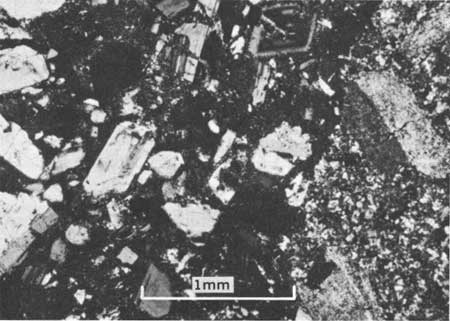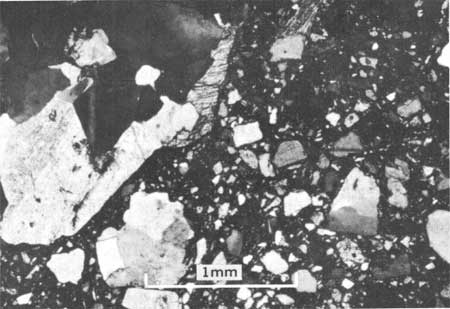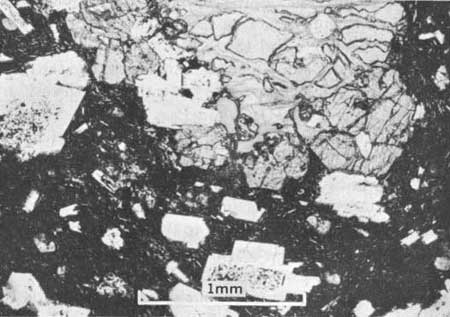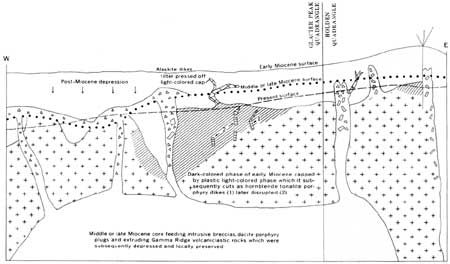
|
Geological Survey Professional Paper 604
On Batholiths and Volcanoes—Intrusion and Eruption of Late Cenozoic Magmas in the Glacier Peak Area, North Cascades, Washington |
EARLY EPISODE OF VOLCANISM: VOLCANIC AND VOLCANICLASTIC ROCKS OF GAMMA RIDGE
GENERAL CHARACTER AND AGE
The oldest eruptive rocks near the Cloudy Pass batholith are altered varicolored volcaniclastic rocks and a few lava flows that crop out on the eastern flanks of Glacier Peak; they underlie Gamma Ridge and occur in four small patches nearby (pl. 1).
Included in this group are ridge-capping tuffaceous conglomerates containing many clasts of granitoid and metamorphic rocks (fig. 21). Mapped with these heterogeneous conglomerates near Gamma Peak, but not actually in contact with them, are conglomerates made up almost entirely of lava clasts of unknown affinity.

|
| FIGURE 21.—View from the south across the head of Dusty Creek to Gamma Ridge. Sketched from several photographs. The cleaver of Glacier Peak ridge-capping lava (Qdc) on left rises about 200 feet above the tuff and breccia of Gamma Ridge. Undivided flows of the summit cone (Qdu). Volcaniclastic rocks of Gamma Ridge (Tgv). |
The thickness of the Gamma Ridge deposits as measured from the base in Dusty Creek or Gamma Creek to the crest of Gamma Ridge is about 2,000 feet. Bedding altitudes within this pile are poorly known. Rocks in Gamma Creek and Dusty Creek have moderate to steep easterly dips. Bedding in the ridge-capping conglomerate dips gently northeastward. However, bedding in a small block of similar heterogeneous conglomerate in Gamma Creek is parallel to the steep valley side; unless the block is a landslide, considerable downfolding or downfaulting is indicated.
The volcanic rocks of Gamma Ridge are between early Miocene and Pleistocene in age. On Gamma Creek, at 3,250 feet altitude, the volcanic rocks overlie the Cloudy Pass batholith and contain cobbles of it; they are thus younger than the batholith at the level now exposed, that is, younger than early Miocene (21 to 24 m.y.). Clearly it took some time, several million years, for erosion to deroof and expose the upper part of the batholith; the maximum age is therefore middle or even late Miocene. The lavas that overlie the Gamma Ridge rocks are the oldest of the Glacier Peak volcano, because they occur as small erosional remnants that cap ridges (unit Qdc, fig. 21); however, these lavas, as will be shown later, are not older than 0.7 m.y. If the Gamma Ridge rocks are derived from the batholith and in the manner considered in the following section, their age is middle or late Miocene or Pliocene.
PETROLOGY
Gamma Ridge is underlain by a wide variety of volcanic and volcaniclastic rocks; lithic wackes, tuffs, welded tuffs, and breccias; flows; and conglomerates. The composition of the extrusives ranges from andesite to dacite and possibly to rhyodacite.
The breccias can be broadly subdivided into volcanic breccias and nonvolcanic breccias, although intermediate types are common. Locally interbedded with them are dark-colored, medium-grained lithic wackes. Fragments in the breccias range in size from a few inches to 80 feet across and are composed both of nearby basement gneiss and schist and of volcanic rocks. Fragments of gneiss and schist are most common at the base of the volcaniclastic pile. In the volcanic breccias and volcanic tuff breccias, most fragments are composed of altered porphyritic-aphanitic rocks, many with flow alined crystals. Most of the breccias are severely altered; unaltered mafic minerals are rare, and calcite, chlorite, and locally zeolites permeate the groundmass.
At the bottom of the Gamma Ridge pile in the gorge of Dusty Creek, greenish-gray volcanic tuff-breccias (figs. 22, 23) are interbedded with gray nonvolcanic breccias (fig. 24) and conglomerates, some of which closely resemble the monolithologic intrusive breccias (figs. 17, 18) on Grassy Point and near the Cool stock.

|
| FIGURE 22.—Volcanic tuff-breccia from lower Dusty Creek Volcanic rock and mineral fragments in an indistinct altered matrix. Plane-polarized light. Specimen DFC—14—62. |

|
| FIGURE 23.—Specimen shown in figure 22 under crossed nicols. |

|
| FIGURE 24.—Monolithologic (nonvolcanic) breccia composed of angular to rounded hornblende tonalite-gneiss fragments (upper left) in clastic matrix of quartz, plagioclase, and epidote. From lower Dusty Creek. Crossed nicols. Specimen DFC—13—63. |
The tuffs are generally fine grained and, like the breccias, are highly altered. They contain a few clasts of granitoid rock, quartz, biotite, and rare volcanic rock, but in general consist of an indistinct mosaic of sodic plagioclase, quartz, rare potassium feldspar, clays, and calcite. Some tuffs are rich in pyrite cubes. Whole-rock X-ray diffraction patterns indicate the presence of considerable sericite and kaolinite. On the south slopes of Gamma Peak, large areas of tuff have been altered to a white siliceous kaolinite rock.
In lower Gamma Creek are two thin layers of altered welded tuff in which shards and flattened pumice lapilli are still visible. Phenocrysts of quartz, biotite, and muscovite suggest that the welded tuffs are rhyodacitic.
The andesite and dacite flows interbedded in the tuffs and breccias are generally dark red brown or grayish green and look like andesites and basalts; indeed, a few of the less altered phenocrysts of plagioclase are andesine or labradorite. However, the rocks are altered and all that can be said about the composition (table 4 and fig. 55) of the lavas is that most range from andesite to dacite. The flows are strongly porphyritic and commonly holocrystalline; a few contain flow-alined microlites (fig. 25). The groundmass is typically a tight mesh of twinned feldspar, quartz, and a green to yellow-brown montmorillonite. Glassy rocks are commonly spherulitic. In the freshest rock, hypersthene, clinopyroxene, and hornblende occur as phenocrysts, but generally mafic minerals are entirely replaced by calcite and a green montmorillonite (fig. 25.) Small veinlets of quartz and zeolites crisscross some flows. Although the lavas of the Gamma Ridge unit look like lavas of Glacier Peak in the field, they can be distinguished in thin section by their higher degree of alteration. The possibility exists that some flows on the south side of Gamma Ridge and the ridge capping dacite between the forks of Milk Creek might be remnants of Glacier Peak lava because they were not seen to be interstratified with altered tuffs and breccias.

|
| FIGURE 25.—Altered porphyritic dacite from Gamma Ridge, south tributary of Gamma Creek. Microlite-rich groundmass (black) surrounds phenocrysts of plagioclase and hypersthene (at top) that is altered to montmorillonite (grayveins). Plane-polarized light. Specimen DFC—115—62. |
The heterogeneous conglomerates that cap Gamma Ridge (fig. 21) are white to dirty gray and purple in color, are poorly bedded and tuffaceous, and are rich in well-rounded cobbles of schist, gneiss, and granitoid rocks of the basement terrain. Conglomerates composed entirely of lava clasts of unknown affinity are included in this unit; their relation to the heterogeneous conglomerates or ridge-capping Glacier Peak lavas is not known. The conglomerates as a whole clearly were derived from a mixed volcanic and basement terrain—a terrain which physiographic evidence suggests was ancestral Lime Ridge to the west.
THE WIDESPREAD ERUPTION OF GAMMA RIDGE TYPE ROCKS
Gamma Ridge eruptive rocks represent a general middle Tertiary episode of volcanism in the Washington Cascades; some of this volcanism appears to be fathered by batholiths. Eruption of Miocene and early Pliocene volcanic rocks from the magma of Snoqualmie batholith was first indicated by Fuller (1925). In the Mount Rainier area, the upper Miocene and lower Pliocene Ellensburg Formation is thought to contain extrusive equivalents of the explosively deroofed Tatoosh pluton and Snoqualmie batholith (reviewed by Fiske and others, 1963, p. 62-63). Hammond (1963, p. 203-205), however, questioned some of the evidence for a direct connection between cupolas of the batholith and effusive equivalents as first given by Smith and Calkins (1906, p. 9 and 13).
Lithologically similar volcanic rocks overlie the composite Chiliwack batholith 66 miles northwest of Gamma Ridge near Hannegan Pass and were extruded between two pulses of batholith intrusion (Misch, 1966, p. 138; Tabor and Crowder, 1968, p. 21-23); they may be extrusive equivalents of the batholith.
Other extrusive rocks in the Washington Cascades that are lithologically similar to the post early Miocene rocks of Gamma Ridge are either of older or of unknown age and have not been closely linked to batholiths. Remarkably similar, but water deposited, is the Ohanapecosh Formation at Mount Rainier, and some what less similar is the Stevens Ridge Formation (Wolfe, 1968; Fiske and others, 1963, p. 3-17; Waters, 1961; Warren, 1941; Smith and Calkins, 1906). Of similar lithology but much less altered is the Fifes Peak Formation (Fiske and others, 1963, p. 27-30; Swanson, 1966, p. 1294).
Bedded volcanic rocks overlying the Cloudy Pass pluton on nearby Lyall Ridge (fig. 52; Libby, 1964, p. 118-119) may be of Gamma Ridge age. The Round Lake plug, a large breccia pipe and volcanic conduit of unknown age and affinity, lies a few miles west of Gamma Ridge (fig. 52; Vance, 1957, p. 288-291).
ORIGIN AND RELATION TO THE CLOUDY PASS BATHOLITH
The presence of welded tuffs and the lack of pillow lavas in the Gamma Ridge rocks points to subaerial eruption and deposition. High local relief along the basal contacts (see p. 55) indicates the terrain was mountainous.
The hypothesis that the magma from the Cloudy Pass chamber erupted as Gamma Ridge rocks (fig. 26) rests on establishing that the intrusive breccias stemmed from the batholith and that they were feeders for the Gamma Ridge rocks. The clustering of intrusive breccias near, over, and adjacent to the southern half of the Cloudy Pass batholith is the best evidence that the breccias stemmed from the batholith (fig. 12).
Two suites of chilled and (on) brecciated intrusive rocks related to the Cloudy Pass batholith in the adjacent Holden quadrangle have been described by Cater (1969). An early suite occurs as a border complex or stems from the presently exposed upper part of the batholith and a later one presumably stems from its not yet exposed core. The border complex is a broad zone of nonporphyritic to highly porphyritic andesite and dacite that occurs along the steep contact near Hart Lake. The chilled rock in this zone both grades into and is intruded by the main pluton. Cater explains most of the chilling in this broad zone not by conventional conduction but by the expansion of gases derived from the core; the gases used this zone as an escape route to the surface (Cater, 1969, p. 48). The "escape route" occurs at a steep dislocation zone between an early satellitic dike of dacite porphyry and the subsequently intruded granodiorite pluton. Of comparable age are dacite porphyry plugs near Plummer Peak that rise from the top of the granodiorite pluton and are considered possible vents. These plugs are locally replaced by sulfides, are chilled, and have a distinctive margin of protoclastic breccia.
The later suite of chilled rocks linked with the batholith according to Cater are lithologically and chemically similar dacite porphyry plugs that are intimately associated with highly cataclastic intrusive breccias. These plugs occur near the batholith in a line along Phelps Ridge and on Bonanza Peak near the aforementioned eastern border; some contain granodiorite inclusions of the Cloudy Pass batholith. The intrusive breccias on Phelps Ridge are altered and mineralized with sulfides, and some thin dikes consist entirely of pulverized material. Such rocks clearly represent a low lithostatic pressure and are considered by Cater as vents for late-stage explosive discharges of dacite magma and gas from the still partly molten core of the batholith.
Analogs of the early suite, that is, the dacite porphyry cupolas of Plummer Peak and the Hart Lake border zone in the Holden quadrangle, are the satellitic stocks (cupolas) in Glacier Peak quadrangle that are decidedly more plutonic; the top of the batholith apparently plunged westward and was thus emplaced under deeper cover. Analogs of the later suite of dacite porphyry plugs and associated intrusive breccias described by Cater are the intrusive breccias of the Glacier Peak quadrangle.
The largest masses of intrusive breccia in the Glacier Peak quadrangle and those which most resemble the basal parts of the Gamma Ridge pile occur on Grassy Point along the steep contacts of the batholith and near the Cool stock, one of its steep-walled cupolas. Magma and pent-up gas in the solidified core of the batholith might most easily escape along contacts of the batholith adjacent to its solid upper parts.
Gamma Ridge rocks lie on the batholith. If these eruptive rocks do stem from its lower core, the batholith must have been exposed by erosion before that core solidified (fig. 26). The time taken for the erosional deroofing can be estimated as 2 to 4 m.y. if the roof was thin, as the epizonal character of the batholith suggests. The core of the batholith could well have remained molten for this time, that is, into middle or late Miocene time.
The hypothesis that the Gamma Ridge rocks are middle or late Miocene eruptive rocks from the Cloudy Pass chamber is not, however, without its problems. Physiographic arguments to follow show that the present course of the Suiattle River was determined by diversion around the Gamma Ridge pile. Thus, if the Gamma Ridge rocks are Miocene, the river's course has been preserved in the face of continual erosion for a very long time (±18 m.y.). The preservation of the rocks themselves, however, can be reconciled by presuming that the Gamma Ridge pile has been down-warped or downfaulted, although direct evidence for this depression is not available. If the Gamma Ridge rocks are significantly younger than Miocene (for example, late Pliocene), these physiographic difficulties are lessened, but a direct descent from the Cloudy Pass batholith would be possible only if the core of the batholith remained molten for an inordinantly long time. Without more definitive data the volcanic and volcaniclastic rocks of Gamma Ridge can only be as signed to the middle or late Miocene or Pliocene Epochs.
| <<< Previous | <<< Contents >>> | Next >>> |
/pp/604/sec2.htm
Last Updated: 28-Mar-2006
